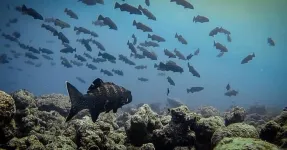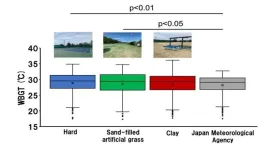(Press-News.org) Populations of squaretail grouper face an uncertain future as new research shows fishing that targets their spawning sites is causing males to be repeatedly scared away from their territories during their short mating meet-ups.
By fleeing for safety, individuals are losing valuable time to catch the eye and court female fish.
A study, led by scientists at Lancaster University and published today in Biology Letters, shows that the impacts of fishing that targets squaretail grouper spawning sites goes beyond those fish that are caught, causing widespread behavioural change in those left behind.
These changes impact ability to reproduce. With disrupted mating, fewer offspring might be created, setting up potential long-term consequences for the survival of their population.
Squaretail grouper gather at very specific spawning aggregation sites for a few days only a handful of times a year – during the new and full moons between December and March.
Male groupers arrive at aggregation sites a few days before new or full moons and establish mating territories to attract females, which they would normally defend vigorously from rivals. Females arrive a day before the new moon and fish will attempt to pair and spawn in synchrony with the moon’s cycles before females leave.
These gatherings at the spawning sites can be the only opportunities for these populations to reproduce. But, fisheries, particular spearfishing, and hook and line fishing, which involve free-diving, have begun targeting and exploiting some of these gatherings intensively to guarantee catches while fish are distracted.
India’s Lakshadweep archipelago, situated north of the Maldives, has restricted access to protect the culture of its people and ecology. However, the opening of new fisheries markets has seen a sharp increase in fishing at some grouper spawning sites around the archipelago over the last five years.
Aggregation densities at the studied fished site has plummeted by 70% in a decade with fisheries targeting groupers all year round.
The marine scientists behind the research had studied some of these sites more than a decade ago and first noticed a change in fish behaviour when attempting to replicate aspects of their earlier study.
“We discovered that we couldn’t film or study the fish as easily at the aggregation sites as we could in the past,” said Dr Rucha Karkarey of Lancaster University and lead author of the research. “We couldn’t get as close to them, they would swim away as though we were predators. It was obvious to us that there was a difference in their behaviour and we realised that the major thing that had changed in the decade since our previous study was the start of fishing at the site.”
The researchers compared male squaretail grouper behaviour at fished and unfished spawning sites, as well as comparing with data gathered from their earlier studies of spawning sites.
They analysed fish fear responses, by simulating a threat. Divers would swim horizontally towards spawning groupers to see how close they could get to a fish before it would flee, as well as the time it spent defending territory and engaged in courtship in the absence of a direct threat.
Although males who had already partnered with females at the fished site took greater risks (from potentially being caught by fishers) during courtship, fleeing later and returning earlier, the study found that single males at fished sites were twice as likely to flee and took two and a half times longer to return to territories than fish at unfished sites.
Fewer than half of the single males returned to their territories at the fished site, while two-thirds of unpaired males at the unfished site returned to their territories.
While escaping early can ensure survival for individuals, escaping too early may mean lost mating opportunities.
Squaretail groupers are a long-lived species, living up to 12 years, so researchers believe the behaviour change may result from fish individuals experiencing fishing.
“Our findings suggest that the stresses caused by fishing are making the fish more nervous and on guard,” said Dr Karkarey. “In turn this is reducing the opportunities for single male groupers to find a mate and reproduce because they are being more vigilant and compromising territorial defence by fleeing. It also means that paired males, that are fitter and more successful at reproducing, are the ones being fished, which can have a consequence for the fitness of this population in the future.
“If a spawning aggregation event only lasts for a short period of time then every hour counts.”
The researchers also found that male groupers at fished sites also spent significantly less time and energy aggressively defending territories from rivals.
The fish at the fished site traded aggressively defending their territories for fleeing. Males spent nearly ten times longer engaged in aggressive behaviour at the unfished site compared to their counterparts at the unfished site.
Researchers believe this could be due to a number of factors including females becoming less choosy in high risk (from fishing) situations, or bolder fish removed from the population by being caught by fishers, though this was not studied.
“Decreased aggression can hold significant evolutionary implications in mating aggregations, specifically through a relaxation in sexual selection, which could have implications for mate choice, population fitness and long-term resilience,” said co-author Dr Sally Keith of Lancaster University.
Dr Idrees Babu from the Department of Scient and Technology, UT Lakshadweep, said: “This study is the first of its kind in these atoll reef islands, and the findings can play an important role in fishery resource management in this archipelago.”
The findings are detailed in the paper ‘Do risk-prone behaviours compromise reproduction and increase vulnerability of fish aggregations exposed to fishing?’ which is published in the journal Biology Letters.
The paper’s authors are Dr Rucha Karkarey, Dr Lisa Bostrom Einarsson, Dr Sally Keith and Professor Nicholas Graham or Lancaster University and local field collaborators and associates Ibrahim MK of Mukkrikakuddi House, U.T Lakshadweep; Mohammed Nowshad and Abdul Riyas of the Research and Environmental Education Foundation, U.T Lakshadweep; and Dr Idrees Babu of the Department of Science and Technology U.T Lakshadweep.
END
Fishing is causing frightened fish to flee when they should flirt
2024-08-07
ELSE PRESS RELEASES FROM THIS DATE:
Your best friend from high school? Here’s why their genes mattered
2024-08-07
Mom always said, “Choose your friends wisely.” Now a study led by a Rutgers Health professor shows she was onto something: Their traits can rub off on you – especially ones that are in their genes.
The genetic makeup of adolescent peers may have long-term consequences for individual risk of drug and alcohol use disorders, depression and anxiety, the groundbreaking study has found.
“Peers’ genetic predispositions for psychiatric and substance use disorders are associated with an individual's own risk of developing ...
How does an effective cancer therapy damage the heart?
2024-08-07
Cytotoxic T-lymphocyte antigen 4 (CTLA-4) is a protein receptor on T immune cells that prevents the cells from killing other cells, such as cancer cells. Blocking CTLA-4 with a specific antibody is an effective treatment for some cancers, but it can damage the heart. New research published in The FASEB Journal reveals the mechanisms involved in this side effect—a finding that could be used to help prevent it.
Experiments conducted in mice showed that blocking CTLA-4 activates certain T cells called Th17 cells, which increase inflammation. Inhibiting this activation reversed ...
How well will different US forests remove atmospheric carbon in the future?
2024-08-07
Forests absorb carbon by capturing carbon dioxide from the atmosphere, making forest carbon stocks an important resource against climate change. In research published in Ecology and Evolution, investigators examined existing tree regeneration patterns to develop an indicator of potential changes to future carbon stocks across forests in the northeastern and midwestern United States.
The scientists’ comparison of carbon stock predictions from tree and seedling composition suggested that 29% of plots were poised ...
Medical issues experienced by women and children after returning from Hamas captivity
2024-08-07
Among the 250 individuals who were kidnapped during the Hamas terror attack on Israeli towns in October 2023, 19 children and 7 women were released and admitted to Schneider Children's Medical Center of Israel after approximately 50 days in captivity, during a cease-fire deal. A new study published in Acta Paediatrica reports on the physical and psychological state of these returnees upon their return.
The most common clinical findings included significant weight loss, psychological trauma, complications of poor hygiene (such as head lice), and complications of recent shrapnel injuries. Tests revealed that returnees also often had ...
Do dieticians have weight biases towards themselves and others?
2024-08-07
In a survey-based study, UK dietitians exhibited significant weight stigma, both towards themselves and towards others.
The study in the Journal of Human Nutrition and Dietetics involved an online survey completed in 2022 by 402 registered dietitians aged 20–70 years old. Most respondents reported personally experiencing weight stigma prior to (51%) and after becoming (59.7%) registered dieticians, and nearly a quarter (21.1%) felt that their weight influenced their own ability to perform as a dietitian.
Weight stigma was experienced across the weight spectrum. Participants reported explicit (or conscious) weight bias attitudes, moderate beliefs that obesity is ...
Can nanomaterials enhance plant tolerance to high soil salt levels?
2024-08-07
Soil salt concentrations above the optimal threshold for plant growth can threaten global food security by compromising agricultural productivity and crop quality. An analysis published in Physiologia Plantarum examined the potential of nanomaterials—which have emerged over the past decade as a promising tool to mitigate such “salinity stress”—to address this challenge.
Nanomaterials, which are tiny natural or synthetic materials, can modulate a plant’s response to salinity stress ...
Study on planet-warming contrails “a spanner in the works” for aviation industry
2024-08-07
Modern commercial aircraft flying at high altitudes create longer-lived planet-warming contrails than older aircraft, a new study has found.
The result means that although modern planes emit less carbon than older aircraft, they may be contributing more to climate change through contrails.
Led by scientists at Imperial College London, the study highlights the immense challenges the aviation industry faces to reduce its impact on the climate. The new study also found that private jets produce more contrails than previously thought, ...
Sea lion camera crews help researchers explore previously unmapped ocean habitats
2024-08-07
The world’s seabeds are little explored, and the knowledge we have is patchy. Using remotely operated underwater vehicles to learn about seabeds is expensive, requires certain weather conditions, and is difficult in deep, remote, and offshore habitats.
To circumvent these challenges, researchers in Australia have now enlisted endangered Australian sea lions (Neophoca cinerea) to carry cameras. The resulting videos allowed the researchers to identify previously unmapped benthic habitats used by the sea lions on the continental shelf. They published their results in Frontiers in Marine Science.
“Using ...
Superbugs spread to family members of recently hospitalized patients
2024-08-07
ARLINGTON, Va. (August 7, 2024) — Family members of patients recently discharged from the hospital may have a higher risk of getting an antibiotic-resistant infection, often called a superbug, even if the patient was not diagnosed with the same infection, suggesting hospitals play a role in the community spread of resistant bacteria, according to study in Infection Control & Hospital Epidemiology, the journal of the Society for Healthcare Epidemiology of America.
When recently hospitalized patients were diagnosed with the superbug — Methicillin-resistant ...
Preventing heat stroke in tennis: insights into the heat environments of tennis courts
2024-08-07
With rising global temperatures due to global warming, the risk of heat strokes has increased and is expected to grow even further. This is particularly troubling for athletes participating in competitive sports. In tennis, multiple matches are played daily, lasting up to five hours. Playing such matches in sweltering conditions could be highly detrimental.
The Tokyo Olympic Games in 2021 faced extremely hot conditions with many players calling for appropriate countermeasures. Consequently, the International Tennis Federation (ITF) formulated and issued the “Extreme Weather Policy” at the Tokyo Olympics to manage matches based ...


